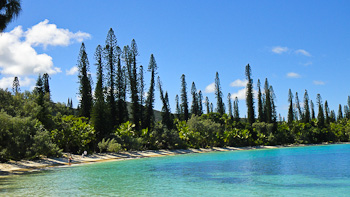
Tenaya
New Caledonia
August
2011
Part Two
| |
| HOME |
| About Tenaya |
| About Us |
| Latest Update |
| Logs from Current Year |
| Logs from Previous Years |
| Katie's View |
| Route Map |
| Links |
| Contact Us |
![]()
August 26, 2011
Noumea
Each morning the round buildings at the end of the quay at Port Moselle burst with a plethora of fresh fruit, vegetables, fish, pastries, flowers, handicrafts and the chatter of vendors and customers. By early afternoon they are shuttered and deserted emitting no signs of life whatsoever.
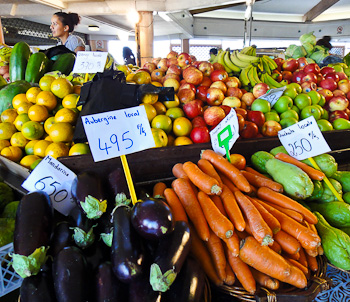
After just eight days at sea we found ourselves again tied up in a berth. The marina at Port Moselle is a nice place with good facilities and helpful people who arrange incoming clearance. All the benefits of a city are within walking distance. The delightful restaurant next door offers free wifi to patrons in surroundings more chic than the MacDonald's up the street, though both have good coffee. On weekends the restaurant has the best live music we have ever heard from a marina, including Europe and the Caribbean. Jazz one night, reggae the next. It was played for the locals, not the tourists. Nice!
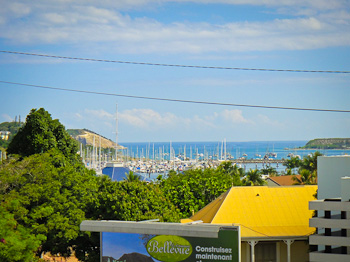
The mix of French and Melanesian people combine to produce warm hospitality and sophisticated elegance. Add in a dash of Asian influence to the multi-ethnic pot and find fashion, food and lifestyle are all pleasantly intertwined. People move about purposefully but not hurriedly in the relaxed city which is surrounded by beautiful azure bays dotted with tiny islets.
Hoards of tiny Peugeots, Citroens, Ford Focuses and motorbikes crowd the main streets of town beginning at dawn. Noumea bustles. It is the capital of New Caledonia where 92,000 people live and work. Because it is a French overseas territory, the citizens are entitled to all the usual benefits. It is an island with resources: money from France, nickel from the earth.
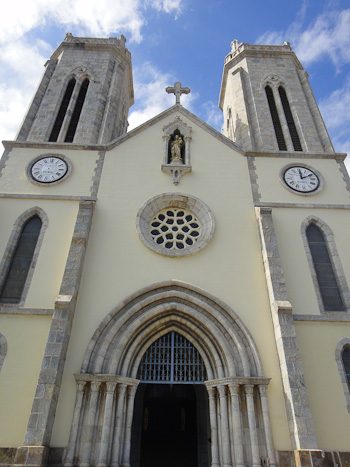
As alluring as the town and environs are, we were committed to fixing some things on Tenaya.
The water leak was straightforward and the inconvenience of its location at the bottom of the cockpit locker was a welcome alternative to its original location in the engine room behind the generator, the generator which will remain inoperable until we return to New Zealand. The problem is in the computerized control board and a Mastervolt technician and parts are required.
A replacement switch repaired the port jib winch so we need not actually grind it again unless we crave exercise.
The VHF radio appears to have fixed itself, enough to use, anyway. The inside handset and the outside speaker work. Not ideal, but something.
The self-steering locking pin at the helm, which was bent when a loose bit of line jammed around it, was welded back together and now glides into place smoothly.
The worrisome whine of the prop or prop shaft remains illusive. We can check no further until Tenaya comes out of the water. The fact that the noise is not constant is, in a small way, somewhat comforting.
Noumea Yacht Services, conveniently located on the quay, proved to be very helpful. They were able to fill our fiberglass butane/propane tanks, provide wifi, and arrange repairmen.

A few chandleries are in town but the majority of services for boats are in Nouville, a 20 minute walk from Port Moselle. On the way we discovered a spot where local kids gather. Below a bridge deep water cuts a narrow passage through shade trees connecting one basin to another. One by one the boys leapt off the bridge to the delight of all. No girls jumped.
Baie Ire at Ile Ouen
The anchorage at Baie Ire is a good stopping point for a trip south to L'Ile des Pins. Holding in the calm bay is excellent in sticky mud. There are no signs of civilization on land, just rugged, colorful hills, dense scrubby foliage and deep red mud shores with two small rivers running out, all beneath a brilliant blue sky.
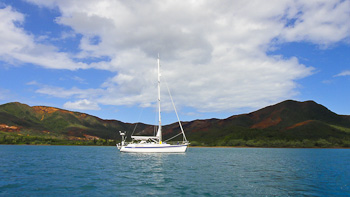

1600 kilometers of reef encircle Grand Terre, the largest island of New Caledonia, and many small islands, including L'Ile des Pins 100 km to the south. It is the largest enclosed lagoon in the world. Magnificent turquoise water is rich with aquatic flora and fauna.
Grand Terre was once part of the ancient super continent of Gondwanaland. Along with New Zealand, it split from Australia 140 million years ago. 80 million years ago it went off on its own. Therefore, it is not of volcanic origin like most South Pacific islands. At 400 km long and 50 km wide, it is the third largest island in the South Pacific after New Zealand and New Guinea. Grand Terre is rich in minerals and is one of the largest nickel reserves in the world.
L'Ile des Pins
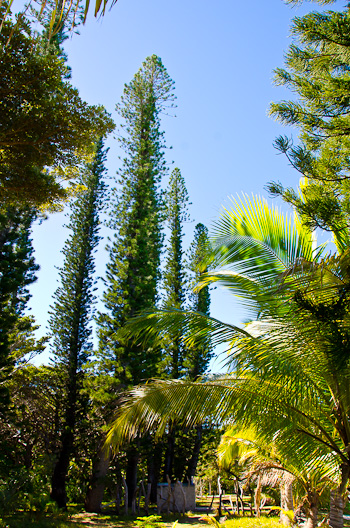
Especially exotic along the shores of the aquamarine bays on L'Ile des Pins are tall, narrow araucaria pines. They reach high into the sky, taller than the swaying palms which usually adorn such idyllic South Pacific locations. Pirogues, the local dug-out canoes, were carved from the trunks of the pines.

The wide canopied and invasive oddly hung roots of Banyan trees are also found here. Deep within the protection of large Banyans is a good place to wait out a cyclone. New Caledonia gets a lot of cyclones.
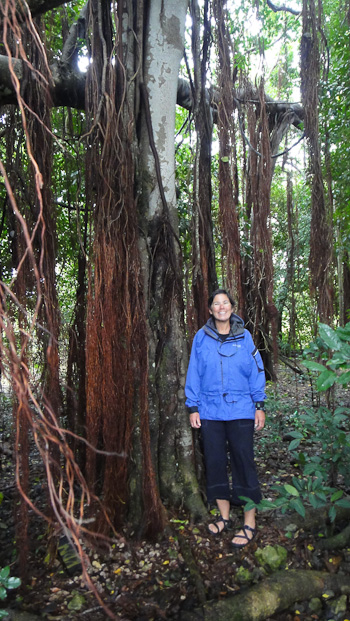
As beautiful as this island is, it was once used as a penal colony housing Paris Communards and Algerian deportees. The crumbling walls of the prison and of the nearby cemetery of the period are still visible beneath the vines and overgrowth.
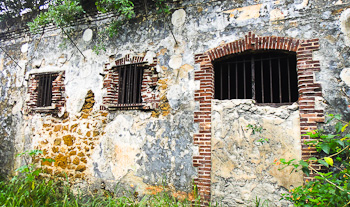


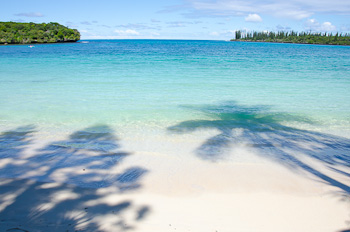
Incredibly picturesque and amazingly tranquil, Baie de Kanumera, on L'Ile des Pins, is an almost round bay edged with ultra-fine white sand. Beyond the sand lies a carpet of grass beneath the arching limbs of fabulous shade trees and the tall, spindly araucaria pines.

Attached to land at low tide by a spit of powdery sand is Le Rocher, a round tree-topped islet plopped at the head of Baie de Kanumera.

The entire area is an underwater sanctuary. Butterflyfish, damsels, various wrasses, parrotfish and surgeonfish swim lazily about fairly unconcerned with the odd snorkeler, though they seem a bit bewildered if someone is actually swimming down at their level. Maybe they are accustomed to the resort visitors and day-trippers who view them while bobbing at the surface.
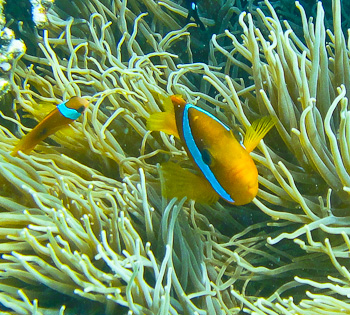
The winter water is chilly here, for the tropics anyway. August is the coldest at 20 degrees, the lowest temperature at which coral can live. Perhaps that is why the coral is not outstanding, but it is there nonetheless, providing shelter and food for many, many fish.

Tenaya is anchored in Baie de Kuto, an equally beautiful and serene bay next to Baie de Kanumera, separated only by a narrow isthmus. Without an islet at its head, it seems much larger. It is an excellent anchorage with a sandy bottom and protected from all but the occasional west wind. A small wharf provides the perfect place to tie up the dinghy.
It was here one day that we came across a man struggling with monofilament and had fairly wrapped up his young grandchildren in an effort to figure out the reel. Jim took hold of the rod and tamed the reel while I untangled the kids and we all contributed to getting the thing in working order. Boy was he impressed with how far he could cast!

Most Wednesdays, Saturdays and Sundays a ferry comes to L'Ile des Pins from Noumea and disgorges day-trippers to enjoy a day in paradise. One particular day there were two ferries though one also seemed to do double duty as a cargo vessel. Occasionally a cruise ship anchors out and ferries passengers to shore in little orange pods. These folks are a boon to the economy and locals set up stalls along the lengthy beach selling brightly colored clothing, jewelry, souvenirs and munchies. Some people are fortunate enough to stay several days in one of the eco-resorts scattered around the island.

Six kilometers south of Kuto is Vao, the largest village on the island. We walked over one day for look but arrived during the mid-day break and nothing but the church was open.
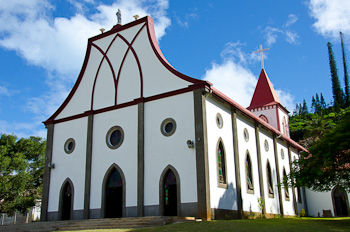
Interesting wooded tiki-like carvings form two fences at Baie de St. Maurice at Vao. One fence runs parallel to the gorgeous bay and the other encircles a statue of Christ which is both a war memorial and a monument honoring the arrival of the first missionaries.
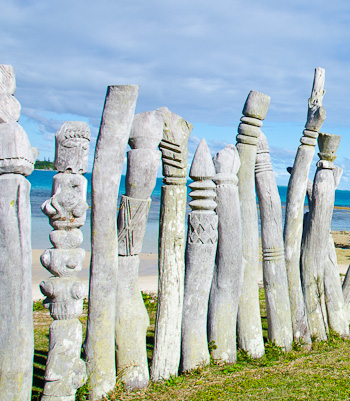
L'Ile des Pins is volcanic in origin though over the millennium the volcano disappeared leaving the reef around it. Gradually the reef was uplifted and the island is now mostly flat and made of porous coral.
The highpoint is Pic N'Ga at 262 meters. We can see the summit from Tenaya and one day decided that it was within our ability to ascend. So we hiked to the top and had an uninterrupted view of the entire island and all the shades of blue that surround it.
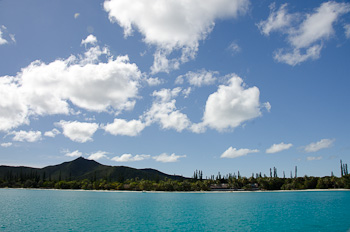


As guests floating in their bay, we have been privileged to see some of the local residents. Once several sightings of a whale-like fluke had us baffled because there were no spouts. After consulting the books, we concluded it was a dugong. Another day one floated lazily at the surface until a passing boat caused it to disappear.
If we gaze out over the water for any length of time, we invariably spot a turtle popping its head up for a breath, and bobbing at the surface, before diving again. They are very yellowish and appear to be wearing dark racoon-like masks.
Tenaya seems to be a haven for sharksuckers, the largest member of the remora family. Some of these fish are nearly a meter long! A group of 10 or so have taken up residency under the boat. They love bread and go into quite a frenzy when tossed chucks of stale baguettes. Because they have been known to attach to divers and swimmers, we, uncourageously, watch them from above.
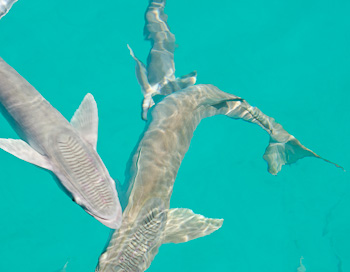
Look what we found hiding under the teak sole of the cockpit - A banded sea snake!
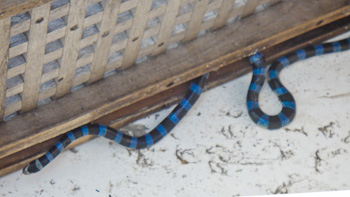
Two days of a mysterious, worsening fishy stench in the cockpit sent us on a mission to identify and get rid of it. When Jim lifted up the latticed teak sole, he was not expecting to find a creature living there.
As much as I'd love a pet on board, this interesting but poisonous serpent would not fill the bill. Over the side he went.
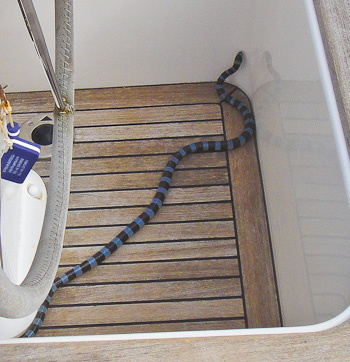
We only meant to stop at L'Ile des Pins for a few days but it is so beautiful and peaceful (except for the scary creatures) that we have stayed. Eventually we plan to sail northeast to the southern islands of Vanuatu.
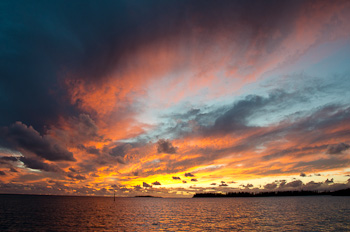
Photo Gallery - New Caledonia Birds
Photo Gallery - New Caledonia Fish
Go to September 2011 Part One - Vanuatu